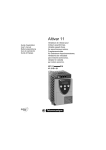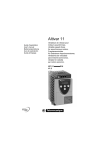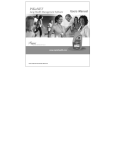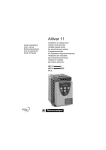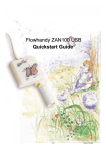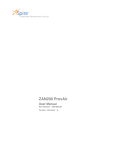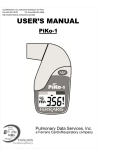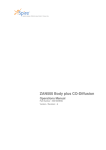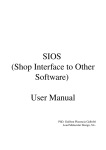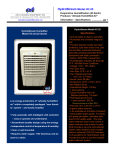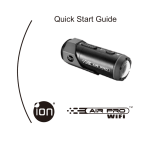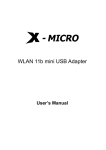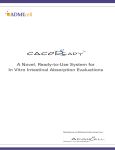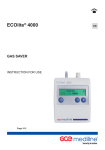Download Cardiac Output - nSpire Health
Transcript
Cardiac Output User Manual Part Number: xxxxxxx ENG Version / Revision: A Cardiac Output User Manual Disclaimer Information in this manual is subject to change without notice and does not represent a commitment on the part of nSpire Health. The software described in this document is furnished under a license agreement. The software may be used or copied only in accordance with the terms of the agreement. It is against the law to copy the software on any medium except as specifically allowed in the license or nondisclosure agreement. No part of this manual may be reproduced or transmitted in any form or by any means, electronic or mechanical, including photocopying and recording, for any purpose without the express written permission of nSpire Health The software is provided "as is" without warranty of any kind, either expressed or implied including but not limited to the implied warranties of merchantability or fitness for a particular purpose. Some states do not allow the exclusion of implied warranties, so the above exclusion may not apply to you. This warranty gives you specific legal rights and you may also have other rights which vary from state to state. nSpire Health does not warrant that the functions contained in the system will meet your requirements or that the operation of the system will be uninterrupted or error free. In no event will nSpire Health be liable to you for any damages, including any lost profits, lost savings or other incidental or consequential damages arising out of the use or inability to use such system even if nSpire Health or an authorised nSpire Health dealer or distributor has been advised of the possibility of such damages, or for any claim by any other party. In the event you should have any claim, whether based on the license agreement, express or implied warranty or otherwise, you agree to accept refund of your money in full satisfaction of your claim. Some states do not allow the limitation or exclusion or liability for incidental or consequential damages so the above limitation or exclusion may not apply to you. www.nspirehealth.com Manufactured for nSpire Health Inc 1830 lefthand Circle, Longmont, Colorado, 80501, USA Tel: 1.800.574.7374 Email: [email protected] Authorized Representative nSpire Health Ltd Unit 10, Hartforde Court John Tate Road Hertford, SG13 7NW U.K. Tel: (+44) (0) 1992.526.300 Email: [email protected] nSpire Health GmbH, Schlimpfhofer Strasse 14 D-97723 Oberthulba Germany Tel: (+49) 097.36.8181.17 (+49) 097.36.8181.27 Email: [email protected] Cardiac Output User Manual Preface Thank you for purchasing the Cardiac Output option. The product complies to the newest state of technical development. In order to improve the lifetime of this product, only materials of extremely high quality are used. All materials are environmentally safe and can be recycled. The manual provides instructions for set up and use the cardiac output option together with the ZAN 600 device. The instructions in this manual assume the user is familiar with the intended use and application of pulmonary-laboratory systems. To avoid damage to the devices or incorrect measurement, it is strongly recommended to follow the introductions in the manual and the technical description. Your nSpire Health-Team Schlimpfhofer Str.14 97723 Oberthulba/Germany Tel. +49 9736 8181-0 Fax +49 9736 8181-20 [email protected] WWW.NSPIREHEALTH.COM nSpire Health GmbH Cardiac Output User Manual Table of Contents 1 HISTORY ...................................................................................................................................................... 2 2 THEORETICAL BACKGROUND............................................................................................................. 2 3 OVERVIEW OVER THE PROCEDURE .................................................................................................. 5 3.1 4 MEASURED AND COMPUTED PARAMETERS .................................................................................... 5 HARDWARE SET UP.................................................................................................................................. 7 4.1 REQUIRED COMPONENTS ............................................................................................................ 7 4.2 ASSEMBLY STEP 1....................................................................................................................... 8 4.3 ASSEMBLY STEP 2....................................................................................................................... 9 4.4 ASSEMBLY STEP 3..................................................................................................................... 10 4.5 ASSEMBLY STEP 4..................................................................................................................... 11 4.6 ASSEMBLY STEP 5..................................................................................................................... 12 4.7 ASSEMBLY STEP 6..................................................................................................................... 13 5 SOFTWARE OVERVIEW ........................................................................................................................ 14 6 MEASUREMENT GUIDELINES............................................................................................................. 15 7 PERFORMING A MEASUREMENT ...................................................................................................... 15 7.1 SYMBOL DEFINITION .................................................................................................................. 16 8 EVALUATION............................................................................................................................................ 17 9 END OF MEASUREMENT....................................................................................................................... 17 10 REVIEWING CARDIAC OUTPUT MANOEUVRES........................................................................ 18 ZAN 600 Cardiac Output 1 - 19 Part No. *****.A Cardiac Output User Manual Cardiac Output Using the Fick Principle 1 History The Fick principle was first described in 1870 by Adolph E. Fick. a German physiologist (1829-1901), after introducing his law of diffusion in 1855, which allows to calculate the diffusion of a gas across a membrane and which has been named after him. Depending on how the gas measurement is done, two different ways to use the Fick principle are in use. The direct Fick method uses blood gas analysis and is an invasive Method. The so called 'indirect Fick' uses measurement of inhaled and exhaled gas in the breath to measure the cardiac output and is a non-invasive method. nSpire Health provides a procedure based on the 'indirect Fick principle'. 2 Theoretical Background In a simplified model of the human blood circuit, all blood from the body is pumped by the right heart through the lung and from here to the left heart from where it is pumped through the body again. All blood, which runs through the lung must be pumped through the left heart to the body again or the lung is flooded with blood and the person will die. Therefore in healthy humans we can approximately say that all the blood, which passes the lung is the amount of blood pumped by the heart, the cardiac output. Simplified model of the human blood circuit The indirect Fick method is a way to approximate the amount of blood that perfuses the lung by measuring the CO2 exhalation. For CO2 we can write: ZAN 600 Cardiac Output 2 - 19 Part No. *****.A Cardiac Output User Manual The mass of CO2 in the pulmonary artery Mp is equal to the mass of CO2 exhaled Mex and the mass of CO2 returning to the left heart Mh. Masses of a gas can be expressed as concentration multiplied by volume Using this: In a closed circuit we can say: A volume divided by a time is a stream. Dividing both sides of the equation by the time Abbreviations: CardOut = VCO2 = CardOut VCO2 Cp Ch = Cardiac output = CO2 stream measured during tidal breathing = CO2 concentration in the blood of the pulmonary artery = CO2 concentration in the blood of the pulmonary vein Now there is a formula to calculate the cardiac output from the CO2 exhalation, the CO2 concentration in the blood which arrives in the lung and the CO2 concentration in the blood which leaves the lung. The CO2 concentration in exhalation stream can be measured directly. What is needed, is to find out about the CO2 concentrations in the lung vessels before and after it has passed the alveoli. ZAN 600 Cardiac Output 3 - 19 Part No. *****.A Cardiac Output User Manual CO2 diffusion from the vessel (V) to the alveolus (A) Carefull examinations proved that the CO2 concentration in the blood which leaves the lung can be calculated with appropriate accuracy from the the CO2 concentration the at the end of exhalation (end tidal CO2 concentration). Indirect Fick Method (non invasive) using a Rebreathing Bag (R) (CO2) The CO2 concentration of the blood which arrives the lung can be calculated from the the CO2 concentration the at the end of the equilibration while rebreathing into a Douglas bag. There are two different methods to determine the equilibration point. The extrapolation method by Defares and the plateau by Collier .The Collier method turned out toprovide the best results for adult individuals. Plateau method (Collier) to determine the cardiac output The method is a good way to approximate the cardiac output especially under load and without invasive techniques. It is easy to perform the test for both, the test person and the researcher. The disadvantage is, that the test is not very exact compared to direct methods or Doppler ultra sound measurement, which both have some problems to provide results under load. The pulmonary shunt volume is not included in the model which leads to the effect, that the results are more accurate under load then in rest condition. ZAN 600 Cardiac Output 4 - 19 Part No. *****.A Cardiac Output User Manual 3 Overview over the Procedure Performing the procedure is easy. All the test person has to do is perform tidal breathing. The procedures starts with the invocation of the CardOut subroutine or emptying of the bag and then starting the CardOut programme. The system is measuring the tidal breath volume and computes the mean values of VT, VCO2 and PETCO2. After the test has been started, the system fills the breathing bag with a volume 1.5 times more than an average tidal breath, with the test gas. The test gas is composed of 10% CO2 and 90% O2 The automatic valve switches to rebreathing position and the measurement is displayed in the measurement window. After 12 seconds the system assumes the equilibration to be completed, switches the valve back to normal breathing position and computes the result line, displayed in the window. The result line can be adjusted manually to the perfect position. If equilibration takes longer or shorter than 12 seconds, the time the systems samples data can be modified changing a parameter in the config.ini file. After the measurement the system waits 60 seconds to start normal data sampling again, to avoid artificially high O2 values getting mixed with regular CPET measurement values. Although the test gas is not harmful to the test person, breathing 10% CO2 is not very comfortable. Some people feel a increasing hunger for breath and force breathing. With regards to the test, this is a beneficial effect and leads to quicker equilibration. In any case the test person must be instructed carefully, so he knows about the effects of the test gas and does not get scared during the procedure. 3.1 Measured and computed parameters Name Unit Meaning Origin Vt [l/min] Volume flow measured VCO2 [l/min] CO2 volume flow (is the mean of the last n breaths before start of equilibration manoeuvre. n is configurable) measured PmvCO2 [mm Hg] mixed venous CO2 partial pressure (alveolar partial CO2 pressure measured at rebreathing equilibrium) measured PetCO2 [mm Hg] End tidal CO2 partial pressure (mean of the last n breaths before start of equilibration manoeuvre. n is configurable) measured SmvO2 [%] Oxygen saturation: mixed venous computed SaO2 [%] Oxygen saturation: arterial computed CmvCO2 [ml/l] CO2 concentration: mixed venous computed CaCO2 [ml/l] CO2 concentration: arterial comuted CardOut [l/min] Cardiac output computed ZAN 600 Cardiac Output 5 - 19 Part No. *****.A Cardiac Output User Manual Formulas: cmvco2 = Cco2FromPco2(pmvco2, SmvO2) caco2 = Cco2FromPco2(petco2, SaO2 ) To convert alveolar partial CO2 pressure to mixed venous/arterial partial CO2 pressure the following formula is used: Pa = 5.5 + 0.9 * PA – 0.0021 * Vt with: Pa = arterial partial pressure PA = alveolar partial pressure Vt = tidal volume (Jones: Clinical Exercise Testing) Cco2FromPco2 (X,Y) is a function to extract cmvco2 and caco2 concentrations values from partial pressures using the curves below Standard CO2 dissociation curve to convert PCO2 into CCO2. (Comroe 1959: The Lung. Clinical Physiology and Pulmonary Function Tests.) ZAN 600 Cardiac Output 6 - 19 Part No. *****.A Cardiac Output User Manual 4 Hardware Set Up 4.1 Required Components The components above are needed to perform the cardiac output measurement according to the indirect Fick principle: A. ZAN600 measurement instrument B. ZAN610 controller C. Measuring head consisting of: 1. 2. 3. 4. 5. 6. Ergo Flow Sensor Pneumo Valve Breath Filter Adapter Breath Filter Breathing Bag Adapter Breathing Bag Two set's of tubing are needed: 1. One set with three tubes (colours blue, yellow, white/black) to connect the ZAN600 with flow sensor and gas suction outlet. 2. And the other set (colours blue, black and yellow) to connect the ZAN610 with the pneumo valve. ZAN 600 Cardiac Output 7 - 19 Part No. *****.A Cardiac Output User Manual 4.2 Assembly Step 1 Plug together all parts of the measuring head like shown below Patient side Make sure the outlet on the Ergo Flow sensor is locked with a stopper. Measuring head assembled Check, if all parts fit tightly together. ZAN 600 Cardiac Output 8 - 19 Part No. *****.A Cardiac Output User Manual 4.3 Assembly Step 2 Connect the tube with the yellow mark to the "Bag" outlet of the ZAN610 on one side and the connector of the pneumo valve on the other side as shown in the pictures. The connectors are marked with arrows. Gas tube connection at the ZAN610 Connect the gas tube to the bottom part of the pneumo valve ZAN 600 Cardiac Output 9 - 19 Part No. *****.A Cardiac Output User Manual 4.4 Assembly Step 3 Connect the tubes with the black and blue marks to the outlets of the ZAN610. The black tube belongs to the connector marked as "Valve L" and the blue one belongs to the connector marked as "Valve R" Tubing at the ZAN610 Next connect the black tube to the left connector of the pneumo valve and the blue one to the right connector of the valve. Left and right is determined from the patient's point of view. Black tube in the left and blue tube in the right connector ZAN 600 Cardiac Output 10 - 19 Part No. *****.A Cardiac Output User Manual 4.5 Assembly Step 4 Connect the tube with the black connector to the outlet of the ZAN600 marked with the word "Analyse. Connection at the ZAN600 side Connection at the pneumo valve side Connect the tube from the "Analyse" port to the connector on the top of the pneumo valve (see above). ZAN 600 Cardiac Output 11 - 19 Part No. *****.A Cardiac Output User Manual 4.6 Assembly Step 5 Connect the tubes with the yellow and blue marks to the outlets of the ZAN600. Connect the tube with the blue mark proximal and the yellow distal on the flow sensor ZAN 600 Cardiac Output 12 - 19 Part No. *****.A Cardiac Output User Manual 4.7 Assembly Step 6 Connect the tube from the pressure reducer of the gas cylinder to the connector at the back of the ZAN610. Gas cylinder Proper connection of the tube from gas cylinder Check all connection for tightness. Connect the USB connectors of the ZAN600 and the ZAN610 devices to the computer. The set up is now ready to work. ZAN 600 Cardiac Output 13 - 19 Part No. *****.A Cardiac Output User Manual 5 Software Overview The procedure is part of the cardiopulmonary exercise test software. After starting the CPET option from the main program, two additional buttons in the top menu are displayed, to control the cardiac output measurement procedure. CPET Main Window The button (or alternatively press 'P' ) to empty the breathing bag and toggle the pump to test if all equipment is up and running. Pressing the button or the [F5] key opens the measurement window below. Cardiac output measurement window Basically all menus have a higher level. button ([ESC]) to cancel the current procedure and return to next It is possible to perform the cardiac output measurement during a running CPET procedure, when the measurement head is connected to a headset. ZAN 600 Cardiac Output 14 - 19 Part No. *****.A Cardiac Output User Manual 6 Measurement Guidelines • Valve of the gas cylinder is open (close again after measurement) • Correct gas mixture (10% CO2 and 90% O2, medical gas) • Breathing bag must be completely empty before start • Use breathing mask or nose clip • Take care to protect the test person against tumbling or collapse Important: We recommend that a doctor or other suitably qualified and experienced physiologist be present during every stress test. A defibrillator should be available. The stress test should be terminated if the heart rate, blood pressure or other vital parameters reach critical values, or if abnormalities become apparent in the ECG signals. 7 Performing a Measurement The Patient puts on the nose clip and starts with normal tidal breathing through the mouth piece. If the patient is under CPET examination, he/she already has the mask on with the measurement head mounted on the outlet. Open the cardiac output measurement window by pressing the [F5] button. Let the patient perform tidal breathing for at least 5 breaths. Press the [P] button to empty the breathing bag. This button has identical functionality as the button in the CPET menu. (see above). After the bag is emptied, press the [Enter] button to start the procedure. Window before starting the procedure The system starts filling the bag with test gas with 1.5 times the volume of a single tidal breath. ZAN 600 Cardiac Output 15 - 19 Part No. *****.A Cardiac Output User Manual When the bag is filled, the window aspect changes and the pneumo valve switches to rebreathing position Start of measurement In the window, the rebreathing curve is displayed. The patient continues breathing. After a predefined time (default 12 sec.), the display switches to the image below and displays the results. The pneumo valve switches back to normal position automatically. Result End of measurement 7.1 Symbol Definition Press this button or [Enter] to save the results and end the procedure Press this button or the up arrow key to move the result line upwards one step Press this button or the down arrow key to move the result line downwards one step ZAN 600 Cardiac Output 16 - 19 Part No. *****.A Cardiac Output User Manual Press this button or [ESC] to cancel the procedure without saving 8 Evaluation Before saving the results with adjust the result line so that it meets the last measured lower half wave. This represents the last measured expiration. Last measured expiration The result line can be moved stepwise using the Save the results pressing [up arrow] and [down arrow]. or the [Enter] key. 9 End Of Measurement After the measurement, close the gas cylinder. After the measurement for a limited time no breath by breath data are recorded. This time is called the PostTime. During the equilibration manoeuvre, oxygen is washed into the lungs. Therefore after the manoeuvre, oxygen is elevated and must be washed out. During washout time, breath-by-breath data are not recorded. This time interval can be configured as PostTime. This time is 60 sec by default and can be modified in the config file. ZAN 600 Cardiac Output 17 - 19 Part No. *****.A Cardiac Output User Manual 10 Reviewing Cardiac Output manoeuvres All manoeuvres can be reviewed offline with a Cardiac-Output-Viewing tool. To review a specific manoeuvre, open the folder C:\ZAN\GPI200\COP with the Windows Explorer and double-click on the manoeuvre data file, for example: ZBodyATSTEST_160309_184250.cop This will open the correspondent window: Use the [up arrow] or Clicking on toolbar button calculation. [down arrow] buttons to move the result line to find a better match. or the [F3] key displays the primary and secondary data from the Changes made during this operations will not be saved to disc. ZAN 600 Cardiac Output 18 - 19 Part No. *****.A





















